 |
| Calderstones
Park c.1907 by J. Hamilton Hey |
 |
| Calderstone
House |
 |
| Fir
Trees |
 |
| The
Four Seasons |
 |
| The
Jubilee Drive |
 |
| The
English Garden |
|
| Calderstones Park |
| In Neolithic times
(4,500 - 2,500 BC), the burial chamber of an
important local figure was constructed in
Allerton, the remains of which became the Calderstones, now located in Calderstones Park
close to their original position. The area must
have had significance for the people of that time
as the site of the park also once included a
large mound called Pyckeloohill (possibly Pikelaw
Hill) with two
standing stones and a 'great stone' known as the Rodgerstone, all since lost. |
| In the centuries
following the Norman Conquest in 1066, the land
was part of the Manor of Allerton and passed
through many changes of ownership. Presiding over
all of this was the Allerton Oak, a tree
said to be about 1000 years old. In mediaeval
times, it reputedly provided shelter for sittings
of the local Hundred Court. It may have suffered
damage in the explosion of the gunpowder ship Lotty
Sleigh on the River Mersey in 1864, and is
now dependent upon a number of props that hold it
up like something in a Salvador Dali painting. |
| Lead shot manufacturer
Joseph Need Walker (1791-1865) acquired the
Calderstone estate in 1825 and built the Georgian
mansion Calderstone in 1828. The house and estate
were bought by shipping magnate Charles I McIver
(1813-1885) in 1875 and passed to his son Charles
II (1851-1926) on his death. Both were sold to
Liverpool Corporation in 1902 and Calderstones
Park as such was opened in 1905 to
accusations of wasting public money. |
| Behind the Mansion House
is a largely wooded area with a magnificent
collection of fir trees, many of North American
origin. Much of this is thought to have been
planted by Charles I McIver, whose involvement in
transatlantic shipping lead him to develop an
interest in the trees of the New World. |
| The adjoining Hart
Hill estate was bought by another shipping
magnate John Bibby (1810-1883), who built his
mansion there. The house and estate eventually
passed to his son Alfred Bibby (1847-1920) in
1898. He sold most of the grounds to Liverpool
Corporation in 1913 to form an extension to
Calderstones Park and making a total of 121 acres
(49 ha). The house fell into disuse and was
demolished in the early 1930s. |
| The imposing entrance to
the park on Harthill Road features the Four
Seasons, statues of allegorical figures of
Spring, Summer, Autumn and Winter. They were
originally located on the roof of Brown's
Buildings, an office block next to the Town Hall
designed by James Picton in 1861-3. This was
demolished in 1926 and the statues were relocated
to their present position in 1928. The gateposts
are supported by giant Atlantes (male
caryatids or Atlas figures). |
| In 1931, the main drive,
a government supported unemployment relief
scheme, was constructed from the Four Seasons
entrance across the park to Yew Tree Road. This
became known as Jubilee Drive in
commemoration of the Silver Jubilee of George V
and Queen Mary in 1935, when the trees were
planted along its length. Also part of the
government scheme was the boating lake, opened in
1933. By this time Calderstones was already being
hailed as Liverpool's most beautiful park. |
| The period 1951-1964 saw
the park become the third location for the
Botanic Gardens originally established by William
Roscoe in Mount Pleasant, Liverpool. Following
the bombing of many of the glasshouses in
Wavertree Botanical Gardens during World War II,
a new glasshouse complex was built here along
with a glazed vestibule, now the home of the
Calderstones. |
| The English Garden,
a walled garden with trellises covered in
climbing plants, seating areas, secluded paths
and a lily pond, and the Flower Garden,
an open plan walled garden with themed planting,
also date from this period. The Bog Garden
was originally a natural pond that had been used
for dumping during the blitz. It was opened in
1955 with a stone bridge spanning a winding
waterway, a valuable habitat for aquatic plants
and animals. |
| The growing botanical
importance of the park encouraged further
horticultural improvements such as the creation
of the Japanese Garden by park apprentices in
1969. It is a haven of peace and tranquility,
sheltered from the wind and pervaded by the sound
of trickling water (sometimes). |
| All of the above
mattered little to the Militant Labour council in
the 1980s, who had most of the glasshouse complex
destroyed in a vindictive action against
gardeners who refused to strike. The collection
of rare and exotic plants was scattered and is
still awaiting a proper home. Graffiti outside
the surviving vestibule once read, 'Destroyed by
the enemy in 1941 and again in 1984'. |
| In 1974, a fine set of
elaborate wrought iron gates was donated to the
park. These originally stood at Bidston Court,
Birkenhead, which was demolished in 1930 and
rebuilt as Hill Bark in Royden Park, Wirral. More
recently the Bluebell Recovery Project
has seen 2,000 bluebells planted on woodland
fringes. |
| Many people still regard
Calderstones Park as Liverpool's most beautiful. |
|
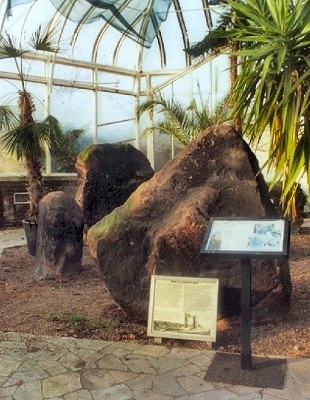 |
| The
Calderstones |
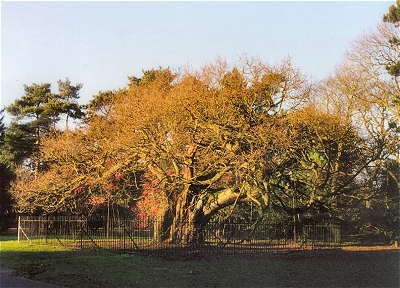 |
| The
Allerton Oak |
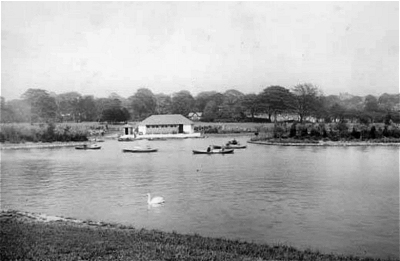 |
| The
Boating Lake c.1935 |
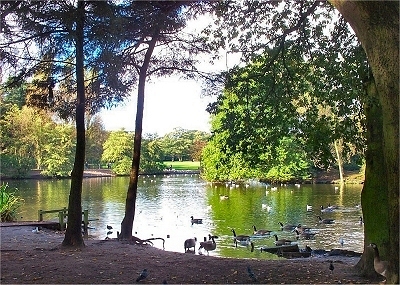 |
| The
Lake Today |
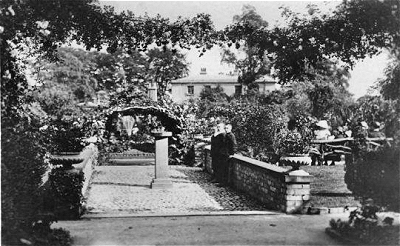 |
| The
English Garden area before its redevelopment |
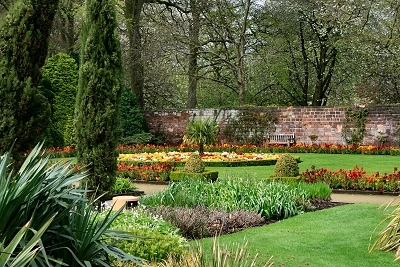 |
| The
Flower Garden |
|